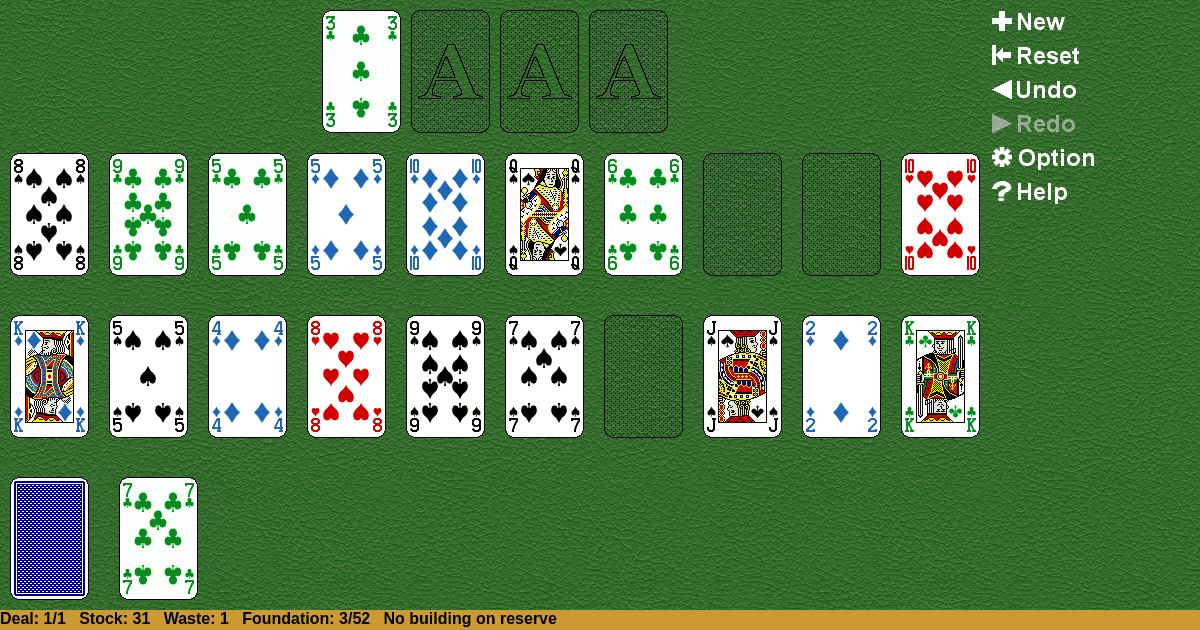Carpet
Home |
How to play |
FAQ |
About
How to play Carpet?
Game Objective:
The primary goal in Carpet Solitaire is to move all cards from the tableau ("carpet"), stock, and waste pile onto the four foundation piles, building each foundation up in ascending order by suit from Ace to King.
Setup & Layout:
- Deck Used: Standard 52-card deck; no jokers.
- Foundations: Remove the four Aces from the deck and place them side by side in a row; these serve as the starting cards for the four foundation piles.
- Carpet (Tableau): Deal 20 cards face-up in a grid below the foundations, arranged as either four rows of five cards or five rows of four cards (the arrangement is flexible, but the total is always 20 cards).
- Stock (Talon): The remaining 28 cards form the stock pile, placed face-down.
- Waste Pile: Cards from the stock that cannot be played immediately are placed face-up in the waste pile.
- Face-Up/Face-Down: All cards in the carpet are dealt face-up. The stock is face-down; the waste pile is face-up, with only the top card available for play.
Play Areas Defined:
- Foundations: Four piles, each beginning with an Ace, built up by suit.
- Carpet/Tableau: 20 face-up cards arranged in a grid; each space holds only one card.
- Stock/Talon: Face-down pile of undealt cards.
- Waste Pile: Face-up pile for unplayable stock cards; only the top card is accessible.
Carpet Solitaire Rules:
- Building Sequences: Foundations are built up by suit, starting from Ace to King (e.g., 2♠ on Ace♠, 3♠ on 2♠, etc.).
- Card Movements:
- Cards from the carpet may be moved directly to the foundations if they follow suit and sequence.
- Cards from the stock are drawn one at a time; each drawn card may be played to the foundations or placed into any empty space in the carpet.
- If a stock card cannot be played to the foundations or carpet, it is placed on the waste pile.
- Only the top card of the waste pile is available for play, either to the foundations or to fill a space in the carpet.
- No Stacking in Carpet: Each carpet space holds only one card; cards cannot be stacked or built upon each other in the carpet.
- Filling Spaces: Any space created in the carpet by moving a card to the foundation must be filled immediately, either by the top card of the waste pile or, if the waste pile is empty, by the next card from the stock.
Gameplay:
- Typical Turn Sequence:
- Move any eligible cards from the carpet to the foundations.
- Draw the top card from the stock. Attempt to play it to the foundations or use it to fill a space in the carpet. If neither is possible, place it on the waste pile.
- After moving a card from the carpet to the foundations, immediately fill the empty carpet space from the waste pile or stock.
- At any time, the top card of the waste pile may be played to the foundations or used to fill a carpet space.
- Introducing New Cards: Cards are introduced into play either by drawing from the stock or moving the top card of the waste pile to the carpet or foundations.
- End of Stock: Once all cards in the stock have been drawn, only the top card of the waste pile remains available for play.
- No Moves Available: If no legal moves remain (i.e., no cards can be played to the foundations or used to fill carpet spaces), the game is lost.
Winning & Losing Conditions:
- Winning: The game is won when all 52 cards have been moved to the foundation piles, each built up by suit from Ace to King.
- Losing/Unwinnable State: The game is lost if the stock is exhausted and no further moves can be made from the carpet or the top card of the waste pile to the foundations or carpet.
Special Rules & Edge Cases:
- Filling Empty Carpet Spaces: Any empty space in the carpet must be filled immediately, first from the waste pile (if available), otherwise from the stock.
- Waste Pile Access: Only the top card of the waste pile is accessible for play or for filling carpet spaces.
- No Rearrangement: Cards in the carpet cannot be rearranged, built upon, or stacked; only one card per space.
- Stock Depletion: Once the stock is exhausted, no redeals or recycling of the waste pile are permitted.
- Variant Difficulty: Some variations reduce the carpet size (e.g., 3 rows of 4 cards) to increase difficulty.
- Spectator Play: The game is designed for solo play but can be observed or assisted by others.
Definitions:
- Foundation: A pile where cards are built up in ascending order by suit, starting with Ace.
- Carpet/Tableau: The main play area consisting of 20 face-up cards, each in its own space.
- Stock/Talon: The remaining deck after setup, face-down, drawn one card at a time.
- Waste Pile: Face-up pile for stock cards that cannot be played immediately; only the top card is available.
This guide is based on official and authoritative sources for Carpet Solitaire.

Solitaire Collection
About Carpet
Rate (Carpet)
4.7 / 5
1,916 votes



























































